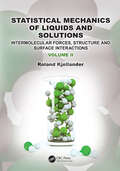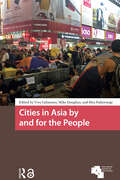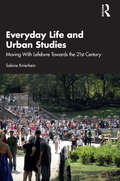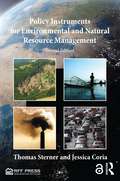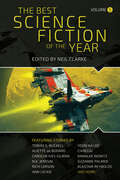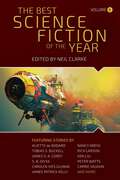- Table View
- List View
Statistical Mechanics of Liquids and Solutions: Intermolecular Forces, Structure and Surface Interactions
by Roland KjellanderThe statistical mechanical theory of liquids and solutions is a fundamental area of physical sciences with important implications in other fields of science and industrial applications. Statistical Mechanics of Liquids and Solutions: Intermolecular Forces, Structure and Surface Interactions is the second in a series of two on this subject. While the first volume introduced equilibrium statistical mechanics in general and statistical mechanics of liquids and solutions at an introductory level, the present volume presents an advanced treatment of the subject and penetrates much deeper into liquid state theory.A major theme in both books is the intimate relationship between forces in a fluid and the fluid structure - a relationship that is paramount for the understanding of the subject of interactions in dense fluids. Using this microscopic, molecular approach, the text emphasizes clarity of physical explanations for phenomena and mechanisms relevant to fluids, addressing the structure and behavior of liquids and solutions under various conditions. A notable feature is the author's treatment of intermolecular interactions in liquids and solutions that include interactions between nanoparticles, macroparticles, and surfaces. The book provides an in-depth treatment of simple liquids, molecular fluids, particle dispersions, dense ionic fluids and electrolyte solutions with molecular solvent, both in the bulk and in confinement. It contains a unified exact treatment of electrolyte solutions, ionic liquids and polar fluids as well as approximate theories and applications.Statistical Mechanics of Liquids and Solutions will be an invaluable resource for graduate and postgraduate students in physics, chemistry, soft matter science, surface and colloid science and related fields, as well as professionals and instructors in those areas of science.
Cities in Asia by and for the People (Asian Cities)
by Mike Douglass Rita Padawangi Yves CabannesThis book examines the active role of urban citizens in constructing alternative urban spaces as tangible resistance towards capitalist production of urban spaces that continue to encroach various neighborhoods, lanes, commons, public land and other spaces of community life and livelihoods. The collection of narratives presented here brings together research from ten different Asian cities and re-theorises the city from the perspective of ordinary people facing moments of crisis, contestations, and cooperative quests to create alternative spaces to those being produced under prevailing urban processes. The chapters accent the exercise of human agency through daily practices in the production of urban space and the intention is not one of creating a romantic or utopian vision of what a city by and for the people ought to be. Rather, it is to place people in the centre as mediators of city-making with discontents about current conditions and desires for a better life. This book examines the active role of citizens in constructing alternative urban spaces as tangible resistance towards capitalist production of space that continues to encroach various neighborhoods.
Everyday Life and Urban Studies: Moving With Lefebvre Towards the 21st Century
by Sabine KnierbeinEveryday Life and Urban Studies revisits the ordinary routines that shape urban life during the crises-ridden last century and early new millennium. Vast parts of Henri Lefebvre’s intellectual work on everyday life however remain underappreciated in urban studies. This book seeks to re-integrate Lefebvre’s Critique of Everyday Life into studies of urbanization. Starting in the 1920s, the book realigns historical insights with contemporary urban phenomena to uncover patterns of capitalist urbanization. By showing the relevance of grasping the minutiae of everyday life to understanding cities, the urban and urbanization today; everyday life, space, and philosophy are brought back in tension. This work combines analytical-methodological exploration, pedagogic mission, and theoretical advances to carve out an everyday-theory-based approach to urban studies situated at the interface of the spatial arts, the humanities, and the social sciences. This book examines the transformative potential that lies hidden in everyday life thereby unravelling a way to nurture hope amid unsettled urban conditions.The book is essential for students, faculty, and researchers in the fields of urban studies, city planning, urban design, human geography, sociology, cultural studies, and political science.
Policy Instruments for Environmental and Natural Resource Management
by Thomas Sterner Jessica CoriaThomas Sterner's book is an attempt to encourage more widespread and careful use of economic policy instruments. The book compares the accumulated experiences of the use of economic policy instruments in the U.S. and Europe, as well as in rich and poor countries in Asia, Africa, and Latin America. Ambitious in scope, it discusses the design of instruments that can be employed in any country in a wide range of contexts, including transportation, industrial pollution, water pricing, waste, fisheries, forests, and agriculture.While deeply rooted in economics, Policy Instruments for Environmental and Natural Resource Management is informed by political, legal, ecological, and psychological research. The new edition enhances what has already been widely hailed as a highly innovative work. The book includes greatly expanded coverage of climate change, covering aspects related to policy design, international equity and discounting, voluntary carbon markets, permit trading in United States, and the Clean Development Mechanism. Focusing ever more on leading ideas in both theory and policy, the new edition brings experimental economics into the main of its discussions. It features expanded coverage of the monitoring and enforcement of environmental policy, technological change, the choice of policy instruments under imperfect competition, and subjects such as corporate social responsibility, bio-fuels, payments for ecosystem services, and REDD.The Open Access version of this book, available at http://www.taylorfrancis.com, has been made available under a Creative Commons Attribution-Non Commercial-ShareAlike (CC BY-NC-SA) 4.0 license.
Applied Sport, Exercise, and Performance Psychology: Current Approaches to Helping Clients
by David Tod Martin EubankApplied sport, exercise, and performance psychology practice has diversified considerably over the years, as consultants have explored various theoretical models to guide them in helping their clients. Applied Sport, Exercise, and Performance Psychology: Current Approaches to Helping Clients provides in-depth and critical coverage, from a global perspective, of the common approaches practitioners now use with clients.Chapters are supplemented with case studies showing the approaches in action. The text explores topics such as: Cognitive behavioural approaches Psychodynamics approaches Family systems therapy approaches Mindfulness approaches Practitioner training and development Cultural considerations in practice Evidence-based practice This text is a vital resource for students in applied sport psychology courses, sport and exercise science courses, and psychology and counselling courses. It is also an invaluable read for practicing applied sport, exercise, and performance psychologists, as well as coachesand parents with some background in psychology.
The Eagle Has Landed: 50 Years of Lunar Science Fiction
by Neil ClarkeIn celebration of the 50th anniversary of the Apollo 11 landing, the endlessly-mysterious moon is explored in this reprint short science fiction anthology from award-winning editor and anthologist Neil Clarke (Clarkesworld, The Best Science Fiction of the Year).On July 20, 1969, mankind made what had only years earlier seemed like an impossible leap forward: when Apollo 11 became the first manned mission to land on the moon, and Neil Armstrong the first person to step foot on the lunar surface.While there have only been a handful of new missions since, the fascination with our planet&’s satellite continues, and generations of writers and artists have imagined the endless possibilities of lunar life. From adventures in the vast gulf of space between the earth and the moon, to journeys across the light face to the dark side, to the establishment of permanent residences on its surface, science fiction has for decades given readers bold and forward-thinking ideas about our nearest interstellar neighbor and what it might mean to humankind, both now and in our future.The Eagle Has Landed collects the best stories written in the fifty years since mankind first stepped foot on the lunar surface, serving as a shining reminder that the moon is and always has been our most visible and constant example of all the infinite possibility of the wider universe.Table of ContentsIntroductionBagatelle by John VarleyThe Eve of the Last Apollo by Carter ScholzThe Lunatics by Kim Stanley RobinsonGriffin&’s Egg by Michael SwanwickA Walk in the Sun by Geoffrey A. LandisWaging Good by Robert ReedHow We Lost the Moon by Paul McAuleyPeople Came From Earth by Stephen BaxterAshes and Tombstones by Brian StablefordSunday Night Yams at Minnie and Earl&’s by Adam Troy CastroStories for Men by John KesselThe Clear Blue Seas of Luna by Gregory BenfordYou Will Go to the Moon by William PrestonSeniorSource by Kristine Kathryn RuschThe Economy of Vacuum by Sarah ThomasThe Cassandra Project by Jack McDevittFly Me to the Moon by Marianne J. DysonTyche and the Ants by Hannu RajaniemiThe Moon Belongs to Everyone by Michael Alexander and K.C. BallThe Fifth Dragon by Ian McDonaldLet Baser Things Devise by Berrien C. HendersonThe Moon is Not a Battlefield by Indrapramit DasEvery Hour of Light and Dark by Nancy KressIn Event of Moon Disaster by Rich LarsonPermissionsAbout the Editor
The Warship (Rise of the Jain)
by Neal AsherThe dangers of ancient technology loom over the Polity in the sequel to The Soldier, Neal Asher&’s latest action-packed space opera series. The haiman Orlandine, charged with safeguarding lethal Jain tech swirling inside an accretion disc located in the distant reaches of space, has weaponized a black hole to eliminate the threat. But others are suspicious of her motives, and both the Polity AIs and the leaders of the alien prador kingdom dispatch fleets of warships in anticipation of conflict. As the black hole continues to eat its way through the planets in the accretion disc, making its way towards a dead sun, it becomes clear the disc has been hiding a larger secret. Nefarious forces with ulterior motives have manipulated Orlandine into deploying the black hole, triggering a series of larger events that will uncover a danger far older than even the Polity itself. From British science fiction writer Neal Asher, The War Ship picks up right where its predecessor, The Soldier, left off, showcasing Asher&’s unique take on cutting-edge and fast-paced science fiction.
Merlin Redux (The Enchanter General)
by Dave DuncanSir Durwin must overcome a cloak-and-dagger plot to usurp the king in the final novel of the Enchanter General, a historical fantasy trilogy set in twelfth century England. King Henry is dead; Richard the Lionheart now rules England. The new king does not believe in magic, and is interested only in a crusade to recapture Jerusalem. But his crusade soon stalls, and while he is away, his brother, John, and his supposed ally, Philip of France, are conspiring to steal his kingdom. Richard&’s mother, Queen Eleanor, sends Sir Durwin, Enchanter General of England, out to Palestine, where he must convince the skeptical king that a loyal magician can be a valuable aide. Meanwhile, King Philip has turned all of Europe into a trap for Richard. The moment the Lionheart sets foot there, he will be arrested and imprisoned for life. It is up to Durwin, aided by his old friend William Legier, to see Richard safely home again and to save the kingdom from falling into the hands of the sadistic and treacherous Prince John . . .
The Best Horror of the Year (Best Horror of the Year)
by Ellen DatlowFor more than three decades, Ellen Datlow has been at the center of horror. Bringing you the most frightening and terrifying stories, Datlow always has her finger on the pulse of what horror readers crave. Now, with the eleventh volume of the series, Datlow is back again to bring you the stories that will keep you up at night.Encompassed in the pages of The Best Horror of the Year have been such illustrious writers as:Neil GaimanKim Stanley RobinsonStephen KingLinda NagataLaird BarronMargo LanaganAnd many othersWith each passing year, science, technology, and the march of time shine light into the craggy corners of the universe, making the fears of an earlier generation seem quaint. But this light creates its own shadows. The Best Horror of the Year chronicles these shifting shadows. It is a catalog of terror, fear, and unpleasantness as articulated by today&’s most challenging and exciting writers.
The Best Science Fiction of the Year (Best Science Fiction of the Year)
by Neil ClarkeFrom Hugo Award-winning editor Neil Clarke, the best science fiction stories of the year are collected in a single paperback volume. Keeping up-to-date with the most buzzworthy and cutting-edge science fiction requires sifting through countless magazines, e-zines, websites, blogs, original anthologies, single-author collections, and more―a task accomplishable by only the most determined and voracious readers. For everyone else, Night Shade Books is proud to introduce the latest volume of The Best Science Fiction of the Year, a yearly anthology compiled by Hugo and World Fantasy Award–winning editor Neil Clarke, collecting the finest that the genre has to offer, from the biggest names in the field to the most exciting new writers. The best science fiction scrutinizes our culture and politics, examines the limits of the human condition, and zooms across galaxies at faster-than-light speeds, moving from the very near future to the far-flung worlds of tomorrow in the space of a single sentence. Clarke, publisher and editor-in-chief of the acclaimed and award-winning magazine Clarkesworld, has selected the short science fiction (and only science fiction) best representing the previous year&’s writing, showcasing the talent, variety, and awesome &“sensawunda&” that the genre has to offer.
Far Out: Recent Queer Science Fiction and Fantasy
by Paula GuranAn Anthology of Recent Queer Science Fiction and Fantasy from Award-Winning Editor Paula GuranSpeculative fiction imagines drastically diverse ways of being and worlds that are other than the one with which we are familiar. Queerness is a natural fit for such fiction, so one would expect it to be customarily included. That has not always been the case, but LGBTQ+ representation in science fiction and fantasy—in both short and long form—is now relatively common. Even so, most of the queer science fiction and fantasy anthologies published in the last thirty-five years have been narrowly focused: specifically gay male or lesbian (or, more recently, transgender) themes, or all science fiction or all fantasy, or adhering to a specific theme or subgenre.Far Out: Recent Queer Science Fiction and Fantasy, on the other hand, features both science fiction and fantasy short fiction from the last decade and includes characters, perspectives, and stories that span the rainbow. With stories from incredible authors ranging from Seanan McGuire to Charlie Jane Anders to Sam J. Miller, it&’s an essential read for anyone interested in queer science fiction and fantasy.ContentsIntroduction: Over the Rainbow and into the Far Out by Paula GuranDestroyed by the Waters by Rachel SwirskyThe Sea Troll&’s Daughter by Caitlín R. KiernanAnd If the Body Were Not the Soul by A. C. WiseImago by Tristan Alice NietoParanormal Romance by Christopher BarzakThree Points Masculine by An OwomoyelaDas Steingeschöpf by G. V. AndersonThe Deepwater Bride by Tamsyn MuirThe Shape of My Name by Nino CipriOtherwise by Nisi ShawlThe Night Train by Lavie TidharOurs Is the Prettiest by Nalo HopkinsonDon&’t Press Charges and I Won&’t Sue by Charlie Jane AndersDriving Jenny Home by Seanan McGuireI&’m Alive, I Love You, I&’ll See You in Reno by Vylar KaftanIn the Eyes of Jack Saul by Richard BowesSecondhand Bodies by Neon YangSeasons of Glass and Iron by Amal El-MohtarNé łe! by Darcie Little BadgerThe Duke of Riverside by Ellen KushnerCat Pictures Please by Naomi KritzerThe Lily and the Horn by Catherynne M. ValenteCalved by Sam J. MillerThe River&’s Children by Shweta Narayan
The Heirs of Babylon
by Glen CookThe dystopian politics of 1984 meet the naval warship backdrop of The Last Ship in fantasy master Glen Cook&’s reissued first novel, available for the first time in decades.It is 2193, and still the war continues.Two hundred years after nuclear and chemical weapons have nearly annihilated the global population, the last of mankind struggles on in isolated communities. Law and order is carried out by the Political Office, black-clad police who rule through fear and violence, commanding the world&’s survivors how to think, how to act, and when to obey the call to the Gathering: the ritual massing for war against an unknown and unseen Enemy.Now the call has come, and all nations must pay tribute.Kurt Ranke is a young man eking out an existence in the ruins of former Germany with his pregnant wife. But when the Gathering is called, he boards the decrepit destroyer Jäger—a once-mighty warship now more than two centuries old. Antiquated, broken-down, and running on steam, it wallows through uncharted waters carrying Ranke and a reluctant and ragtag group of soldiers en route to the Final Meeting: a battle from which it&’s rumored none have ever returned . . .Night Shade Books is proud to reissue, for the first time and now with a brand-new foreword from the author, The Heirs of Babylon, Glen Cook&’s long-unavailable debut novel, a dark blend of post-apocalyptic naval warfare, Orwellian political intrigue, and the intimate, war-correspondent prose the author is known for.
Breath of Gods: The Legacy of the Heavens, Book Three
by Tina LeCount MyersThe overlapping worlds of gods and men collide in the concluding volume of an epic fantasy trilogy set in cold harsh arctic lands.In the Northlands of Davvieana, power rests in the hands of the High Priest of the Order of Believers. But his earthly supremacy is contested. Those few Piijkij that remain continue to honor the oath of the Brethren of Hunters: protect the Olmmoš people from danger. This time, however, it is not the immortal Jápmemeahttun who represent a threat to human freedom, but their own kind. Against insurmountable odds, this small band of dedicated men will use any and all means open to them to bring down the man who betrayed them all.The struggles of men, however, mean little to the immortals beyond the vail in the Song of All. Vanquished, facing a doomed existence, any hope for a future slowly slips away as the best efforts of Dárja and Marnej prove inadequate. When they both fail to safeguard those closest to them, the bond between these two unlikely allies, forged by necessity and emboldened by a tentative passion, may not be enough to overcome the secrets and lies that have shadowed their lives.When betrayal and shame guide the future, the outcome can be treacherous. For both humans and immortals to find their way forward, they must seek out those who offer an unprecedented vision over a quest for power.
The Best Science Fiction of the Year (Best Science Fiction of the Year)
by Neil ClarkeFrom Hugo Award-Winning Editor Neil Clarke, the Best Science Fiction Stories of the Year Collected in a Single Paperback VolumeKeeping up-to-date with the most buzzworthy and cutting-edge science fiction requires sifting through countless magazines, e-zines, websites, blogs, original anthologies, single-author collections, and more—a task that can be accomplished by only the most determined and voracious readers. For everyone else, Night Shade Books is proud to present the latest volume of The Best Science Fiction of the Year, a yearly anthology compiled by Hugo and World Fantasy Award–winning editor Neil Clarke, collecting the finest that the genre has to offer, from the biggest names in the field to the most exciting new writers.The best science fiction scrutinizes our culture and politics, examines the limits of the human condition, and zooms across galaxies at faster-than-light speeds, moving from the very near future to the far-flung worlds of tomorrow in the space of a single sentence. Clarke, publisher and editor-in-chief of the acclaimed and award-winning magazine Clarkesworld, has selected the short science fiction (and only science fiction) best representing the previous year&’s writing, showcasing the talent, variety, and awesome &“sensawunda&” that the genre has to offer.
Summer Thieves
by Paul Di FilippoA masterful, witty, picaresque science fiction adventure story evoking the styles of Gene Wolfe and Jack Vance, The Summer Thieves is the first novel in the new Quinary series by noted author and reviewer Paul Di Filippo. He chased his dreams of the ideal summer across a galaxy of thieves . . .Far in the glorious interstellar future, a time of riches and complex technologies, the stern but utilitarian Quinary guards and regulates the flourishing human-colonized galaxy. Under their business-like rule, a family may own a whole planet. And so two bloodlines—the Corvivios clan and the Soldavere clan—are in full possession of the lush and benign world of Verano. The youngest members of each family—Johrun Corvivios and Minka Soldavere—are slated to wed. All looks rosy for the joint family enterprises. But then the happy future is dramatically and tragically overturned! Circumstances separate the lovers and rob them of their places in the galaxy, and Johrun must undertake a desperate quest across the stars to reclaim his birthright. At first aided only by his devoted chimeric helper, the canny Lutramella, Johrun will face a thousand deadly challenges, from malign magicians to haughty outlaws. As his character is matured in fire, his dedication to Verano and his determination to return increase, and his group of friends and allies becomes stronger . . . but will the precious Summer Planet, and his bride-to-be, even be the same when—and if—he returns?
The Best Horror of the Year (Best Horror of the Year)
by Ellen DatlowFrom Ellen Datlow (&“the venerable queen of horror anthologies&” (New York Times) comes a new entry in the series that has brought you stories from Stephen King and Neil Gaiman comes thrilling stories, the best horror stories available.For more than three decades, Ellen Datlow has been at the center of horror. Bringing you the most frightening and terrifying stories, Datlow always has her finger on the pulse of what horror readers crave. Now, with the eleventh volume of the series, Datlow is back again to bring you the stories that will keep you up at night. Encompassed in the pages of The Best Horror of the Year have been such illustrious writers as: Neil Gaiman, Kim Newman, Stephen King, Linda Nagata, Laird Barron, Margo Lanagan, and many others.With each passing year, science, technology, and the march of time shine light into the craggy corners of the universe, making the fears of an earlier generation seem quaint. But this light creates its own shadows. The Best Horror of the Year chronicles these shifting shadows. It is a catalog of terror, fear, and unpleasantness as articulated by today&’s most challenging and exciting writers.
Mythic Journeys: Retold Myths and Legends
by Paula GuranAward-winning editor Paula Guran presents a diverse reprint anthology collecting classic myths and legends, retold by today&’s top fantasy writers.The Native American trickster Coyote . . . the snake-haired Greek Gorgon Medusa, whose gaze turned men to stone . . . Kaggen, creator of the San peoples of Africa . . . the Holy Grail of Arthurian legend . . . Freyja, the Norse goddess of love and beauty . . . Ys, the mythical sunken city once built on the coast of France . . . Ragnarok, the myth of a world destroyed and reborn . . . Jason and the Argonauts, sailing in search of the Golden Fleece . . .Myths and legends are the oldest of stories, part of our collective consciousness, and the source from which all fiction flows. Full of magic, supernatural powers, monsters, heroes, epic journeys, strange worlds, and vast imagination, they are fantasies so compelling we want to believe them true.This new anthology compiles some of the best modern short mythic retellings and reinvention of legend from award-winning and bestselling authors, acclaimed storytellers, and exciting new talent, offering readers new ways to interpret and understand the world. Adventure with us on these Mythic Journeys . . .TABLE OF CONTENTSIntroduction: A Map or Maybe Not&“Lost Lake&” – Emma Straub and Peter Straub&“White Lines on a Green Field&” – Catherynne M. Valente&“Trickster&” – Steven Barnes and Tananarive Due&“Our Talons Can Crush Galaxies&” – Brooke Bolander&“A Memory of Wind&” – Rachel Swirsky&“Leda&” – M. Rickert&“Chivalry&” – Neil Gaiman&“The God of Au&” – Ann Leckie&“Faint Voices, Increasingly Desperate&” – Anya Johanna DeNiro&“Ogres of East Africa&” – Sofia Samatar&“Ys&” – Aliette de Bodard&“The Gorgon&” – Tanith Lee&“Merlin Dreams in the Mondream Wood&” – Charles de Lint&“Calypso in Berlin&” – Elizabeth Hand&“Seeds&” – Lisa L. Hannett and Angela Slatter&“Wonder-Worker-of-the-World&” – Nisi Shawl&“Thesea and Astaurius&” – Priya Sharma&“Foxfire, Foxfire&” – Yoon Ha Lee&“Owl vs. the Neighborhood Watch&” – Darcie Little Badger&“How to Survive an Epic Journey&” – Tansy Rayner Roberts&“Simargl and the Rowan Tree&” – Ekaterina Sedia&“The Ten Suns&” – Ken Liu&“Armless Maidens of the American West&” – Genevieve Valentine&“Give Her Honey When You Hear Her Scream&” – Maria Dahvana Headley&“Zhyuin&” – John Shirley&“Immortal Snake&” – Rachel Pollack&“A Wolf in Iceland Is the Child of a Lie&” – Sonya TaaffeAbout the AuthorsAbout the EditorAcknowledgements
Kingdoms of the Cursed: The High and Faraway, Book Two (The High and Faraway)
by Greg KeyesThree young friends must navigate dangerous magical worlds―and their own inner selves―in this sweeping fantasy from Greg Keyes, the sequel to The Reign of the Departed.Errol Greyson is awake and back in his own body, thanks to his friends Aster the witch and Veronica the half-dead girl. Unfortunately, due to the attempted suicide that led to his months-long coma and temporary reincarnation in Aster&’s wooden automaton in the first place, he&’s also in a mental hospital. But when the last person Errol expects breaks him out and forces him back to the magical Kingdoms, he has no other option but to attempt to undo a deadly curse threatening reality itself, in hopes of returning the realm to equilibrium. It&’s dangerous business, especially in Errol&’s merely-human form, weakened from months in bed. Fearing for their friend&’s life, Aster and Veronica follow, but are quickly separated. Aster is captured by an ancient evil―the source of the curse―while Veronica confronts a mysterious admirer, her own evolving nature, and the dark spirit that murdered her years earlier. As vast armies collide and dragons take wing, the friends must find each other―and themselves―again.
The Human (Rise of the Jain)
by Neal AsherIn The Human, the final book in Neal Asher&’s epic Rise of the Jain trilogy, an entire galaxy hangs in the balance as the ancient and powerful Jain threat emerges anew . . .A Jain warship has risen from the depths of space, emerging with a deadly grudge and a wealth of ancient yet lethal technology. It is determined to hunt down the alien Client, and will annihilate all those who stand in its way. So Orlandine must prepare humanity&’s defense.Both humanity and the Prador thought their ancient foe—the Jain—had perished in a past age. And they resolve to destroy these outliers at any cost. Orlandine wants the Client&’s inside knowledge to act, but the Client has her own agenda. Earth Central therefore looks to the Prador for alliance, after the Jain destroy their fleet. However, not everyone is happy with this, and some will do anything to shatter this fragile coalition.As the Jain warship makes its way across the galaxy, it seems unstoppable. Human and Prador forces alike struggle to withstand its devastating weaponry. Orlandine&’s life work is to neutralize Jain technology, so if she can't triumph, no one can. But will she become what she&’s vowed to destroy?
Really, Really, Really, Really Weird Stories
by John ShirleyJohn Shirley takes us on a journey from the mildly bizarre to the downright weird and then some in this, his latest collection of short fiction. The book incorporates some of Shirley's classic stories along with some revised and hard to find material and is highlighted by nine never before published works. A must have for the Shirley reader or collector. Includes art work by Alan M. Clark.Skyhorse Publishing, under our Night Shade and Talos imprints, is proud to publish a broad range of titles for readers interested in science fiction (space opera, time travel, hard SF, alien invasion, near-future dystopia), fantasy (grimdark, sword and sorcery, contemporary urban fantasy, steampunk, alternative history), and horror (zombies, vampires, and the occult and supernatural), and much more. While not every title we publish becomes a New York Times bestseller, a national bestseller, or a Hugo or Nebula award-winner, we are committed to publishing quality books from a diverse group of authors.
Sculptor: A Novel
by Michael Aronovitz"The Sculptor is one of the most grimly terrifying serial killers in recent literature.&”—Horror scholar and editor ST JoshiAt age seven, Michael Leonard Robinson commits his first murder, turning tragedy into an aesthetic. By the time he turns eighteen, he has become an expert with computers, gaming systems, and the art of video imaging. And now in his forties, fully realized, he has long erased his digital footprint. He is thirty years ahead of our most advanced scientists, military ops tacticians, and elite information tech specialists. He is a master of disguise. He can invent projected realities.Of course, Michael Leonard Robinson could work his dark vision on a global scale, yet he doesn&’t need &“the world&” for a fetishistic thrill, just a police captain, his receptionist, a detective, a rookie junior officer, his sister and mother, and a lot of dark theater. Robinson appears to these characters in disguise, film clips, and flashes as he torments them. Their multiple viewpoints are puzzle pieces.When they fuse to finish the puzzle, the final sculpture becomes clear.
Weaponized
by Neal AsherWeaponized is a thrilling far-future adventure by acclaimed science fiction author Neal Asher.A bright new future for humanity – or a dark and inescapable past.With the advent of new AI technology, Polity citizens now possess incredible lifespans. Yet they struggle to find meaning in their longevity, seeking danger and novelty in their increasingly mundane lives.On a mission to find a brighter future for humanity, ex-soldier Ursula fosters a colony on the hostile planet Threpsis. Here, survival isn&’t a given, and colonists thrive without their AI guidance. But when deadly alien raptors appear, Ursula and her companions find themselves forced to adapt in unprecedented ways. And they will be pushed to the very brink of what it means to be human.As a desperate battle rages across the planet, Ursula must dig deep into her past if she is to save humanity&’s future.
Best Science Fiction of the Year (Best Science Fiction of the Year)
by Neil ClarkeFrom Hugo Award-Winning Editor Neil Clarke, the Best Science Fiction Stories of the Year Collected in a Single Paperback VolumeKeeping up-to-date with the most buzzworthy and cutting-edge science fiction requires sifting through countless magazines, e-zines, websites, blogs, original anthologies, single-author collections, and more—a task that can be accomplished by only the most determined and voracious readers. For everyone else, Night Shade Books is proud to present the latest volume of The Best Science Fiction of the Year, a yearly anthology compiled by Hugo and World Fantasy Award–winning editor Neil Clarke, collecting the finest that the genre has to offer, from the biggest names in the field to the most exciting new writers.The best science fiction scrutinizes our culture and politics, examines the limits of the human condition, and zooms across galaxies at faster-than-light speeds, moving from the very near future to the far-flung worlds of tomorrow in the space of a single sentence. Clarke, publisher and editor-in-chief of the acclaimed and award-winning magazine Clarkesworld, has selected the short science fiction (and only science fiction) best representing the previous year&’s writing, showcasing the talent, variety, and awesome &“sensawunda&” that the genre has to offer.
The Best of Glen Cook: 18 Stories from the Author of The Black Company and The Dread Empire
by Glen CookThe best short fiction of legendary author Glen Cook (The Black Company, the Dread Empire) is collected into a new volume.For over forty years, Glen Cook has been among the most well-known, influential, and widely respected authors in science fiction and fantasy. Through classic series such as The Black Company, Garrett P.I., the Dread Empire, Starfishers, Darkwar, and more, his gritty, down-to-earth style left an indelible impression on his readers around the world, forever shifting the genre landscape and carving out his place as a pioneering icon.The Best of Glen Cook collects eighteen of his greatest stories—as chosen and introduced by the author himself—including a new, never-before-published Black Company novelette. With works set in all of his most famous series, these tales of science fiction and fantasy offer both the perfect way for longtime fans to trace Cook&’s history and for new readers to become familiar with one of the finest genre authors of the twentieth century.
Jack Four (Jack Four)
by Neal AsherThis high-octane adventure is set in the same world as Neal Asher's acclaimed Polity universe. It's a thrilling, fast-paced standalone novel, perfect for fans of Alastair Reynolds and Stephen Baxter.Created to die–determined to live . . .Jack Four–one of twenty human clones–has been created to be sold. His purchasers are the alien prador and they only want him for their experimentation program. But there is something different about Jack. No clone should possess the knowledge that&’s been loaded into his mind. And no normal citizen of humanity&’s Polity worlds would have this information.The prador&’s king has been mutated by the Spatterjay virus into a creature even more monstrous than the prador themselves. And his children, the King&’s Guard, have undergone similar changes. They were infected by the virus during the last humans-versus-prador war, now lapsed into an uneasy truce. But the prador are always looking for new weapons – and their experimentation program might give them the edge they seek.Suzeal trades human slaves out of the Stratogaster Space Station, re-engineering them to serve the prador. She thinks the rewards are worth the risks, but all that is about to change. The Station was once a zoo, containing monsters from across known space. All the monsters now dwell on the planet below, but they aren&’t as contained as they seem. And a vengeful clone may be the worst danger of all.&‘Neal Asher&’s books are like an adrenaline shot targeted directly for the brain&’John Scalzi, author of the Old Man&’s War series'Magnificently awesome. Then Asher turns it up to eleven'Peter F. Hamilton, author of Salvation and others, on Asher's The Soldier
